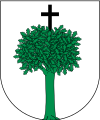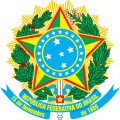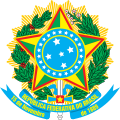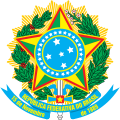Coat of arms of Brazil facts for kids
Quick facts for kids Coat of arms of Brazil |
|
|---|---|
 |
|
| Armiger | Federative Republic of Brazil |
| Adopted | 11 May 1992 |
| Supporters | A Mullet parted gyronny of ten Or and Vert, charged with a Sword in pale, pommelled Or, hilted Azure, and in the centre of the hilt, Gules charged with a mullet of five points Or, to the dexter, a sprig of coffee proper, and to the sinister, a sprig of tobacco, also proper, tied together by a ribbon Azure. |
| Motto | República Federativa do Brasil - 15 de Novembro de 1889 (Portuguese: 'Federative Republic of Brazil - 15 November 1889') |
The coat of arms of Brazil (Portuguese: Brasão de Armas do Brasil) is an important national symbol. It was created on 19 November 1889. This was just four days after Brazil became a republic, changing from an empire.
The main part of the coat of arms is a central design. This design is surrounded by branches of coffee and tobacco. These plants were very important crops for Brazil at that time. In the round shield at the center, you can see the Southern Cross (Cruzeiro do Sul). This is a famous group of stars visible in the Southern Hemisphere. A ring of 27 stars goes around the shield. These stars stand for Brazil's 26 states and the Federal District.
A blue ribbon is at the bottom of the coat of arms. On the first line, it shows Brazil's official name: República Federativa do Brasil. This means 'Federative Republic of Brazil'. Before 1964, it said 'United States of Brazil'. The second line has the date 15 November 1889. This is the day the Republic was officially declared in Brazil.
Contents
What the National Arms Mean
The design of Brazil's National Arms was set by a law in 1968. It has specific parts that tell a story about the country.
- The main part is a round, sky-blue shield. Inside it, five silver stars form the Southern Cross. This constellation is a key symbol of Brazil. The edge of the shield is gold and has silver stars. These stars are the same as the ones on the National Flag.
- The shield sits on a larger star shape. This star has ten points and is green and gold. It has two borders, one red and one gold.
- Behind everything is a sword pointing upwards. Its handle is blue with a red center that holds a silver star.
- Around the sword and shield are two branches. One is a coffee branch with berries. The other is a tobacco branch with flowers. Both are shown in their natural colors. They are tied together with a blue ribbon.
- All these parts are placed on a golden "splendor." This makes the whole design look like a bright, 20-pointed star.
Brazil's Imperial Coat of Arms
Before Brazil became a republic, it was an empire. The Empire of Brazil had its own coat of arms. This symbol was used by Emperors Pedro I and Pedro II. It was used until the monarchy ended in 1889.
The first version of the imperial arms was created on 18 September 1822. This was just eleven days after Brazil declared its independence. The design featured a green background with a gold Armillary sphere. This sphere had a Portuguese cross on it. Nineteen silver stars circled the sphere on a blue background. An imperial crown sat on top of the shield. The sides of the shield were decorated with coffee and tobacco plants. These plants showed the empire's wealth.
When Brazil became an empire on 12 October 1822, this design became the Imperial Coat of Arms. The number of stars on the coat of arms changed over time. It always matched the number of provinces in the Brazilian Empire.
The crown on the imperial coat of arms also changed twice. At first, it showed the Royal Crown of Portugal. Later, it showed the Imperial Crown made for Emperor Pedro I. Finally, when Emperor Pedro II was crowned in 1841, a new, richer crown was made for him. The image of this new crown then replaced the older one on the coat of arms. This final design was used until the empire ended.
The Republican Coat of Arms

The current Republican coat of arms was adopted in 1889. This happened right after the Proclamation of the Republic. It was designed by Artur Zauer, an engineer, and Luís Gruder, a lithographer. They worked together and presented the symbol to Marshal Deodoro da Fonseca. He was Brazil's first President of Brazil. He liked it right away and made it the official national coat of arms.
The coat of arms has had a few small changes since then. In 1968, its colors were made brighter. Then, in 1971 and 1992, more stars were added to the design. This was done to represent the new states that were created in Brazil.
Gallery
-
Coat of arms of Colonial Brazil (1500–1815)
-
Coat of arms of the United States of Brazil (1889–1968)
-
Coat of arms of the Federative Republic of Brazil (1968–1971)
See also
 In Spanish: Escudo del Brasil para niños
In Spanish: Escudo del Brasil para niños
- Flag of Brazil
- Brazilian heraldry
- Armorial of Brazil
- Coat of arms of Dutch Brazil










